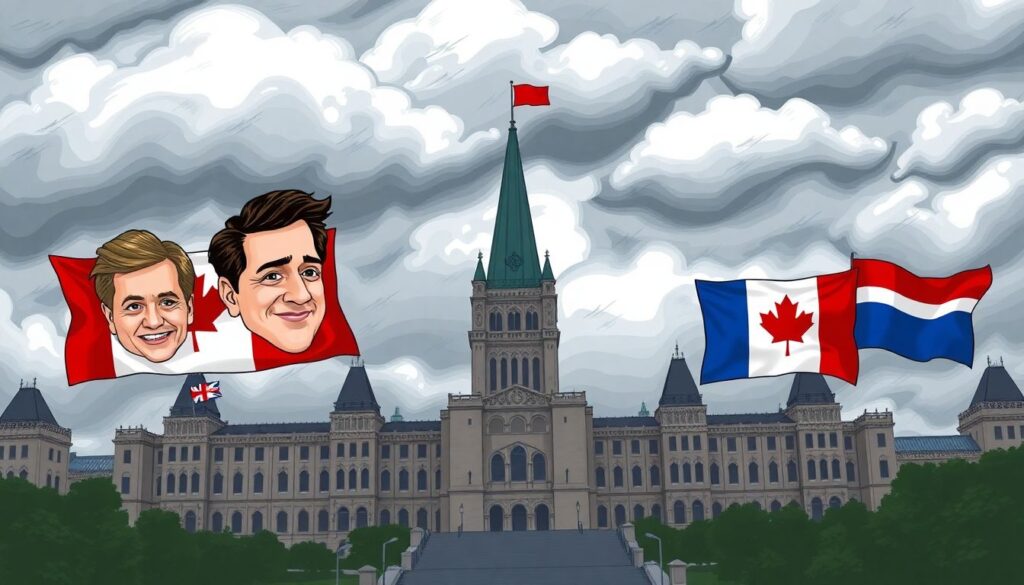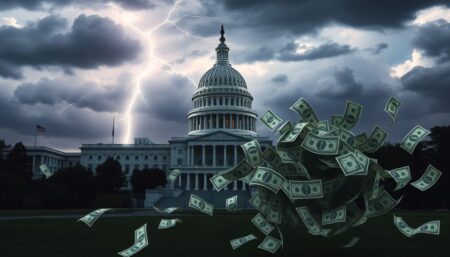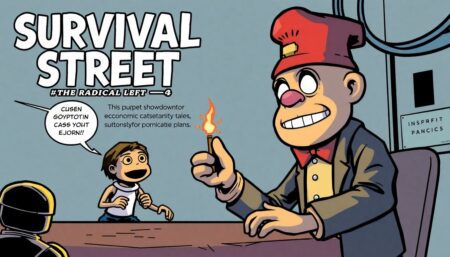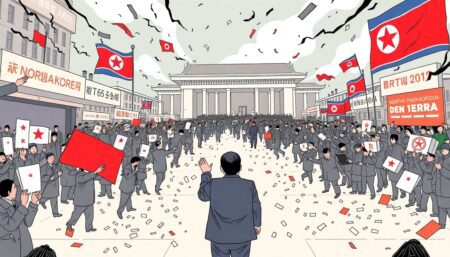Buckle up, dear readers! We’re about to embark on a wild ride through the tumultuous landscape of Canadian federal politics. This isn’t just about the rise and fall of political parties; it’s about the very fabric of our democracy and the pressing need to understand how we got here and where we’re headed.
A deep dive into the cracks in our political system and the impending storm
Imagine the iconic Parliament Hill, the heart of Canada’s democracy, under a sky that tells a tale of its own. The sun is eclipsed by gathering storm clouds, their edges tinged with an ominous hue, symbolizing the impending political chaos that’s been brewing in the hallowed halls below.
As the wind begins to blow, caricatures of key political figures appear, clutching their party’s flags like captains steering ships through turbulent waters. There’s Justin Trudeau, his recognizable coiffure slightly disheveled, holding onto the Liberal banner with a determined grip. Beside him, prominent Liberal MPs stand tall, their expressions a mix of resolve and apprehension.
On the other side, Conservative MPs plant their feet firmly on the ground, their flag bearing the party’s blues and (soon to change) greens fluttering in the wind. Their caricatures, drawn with exaggerated features, reflect a sense of urgency and preparedness. The scene is set for a political storm, with each figure bracing for the impact, ready to defend their ideologies and the future of Canadian politics.
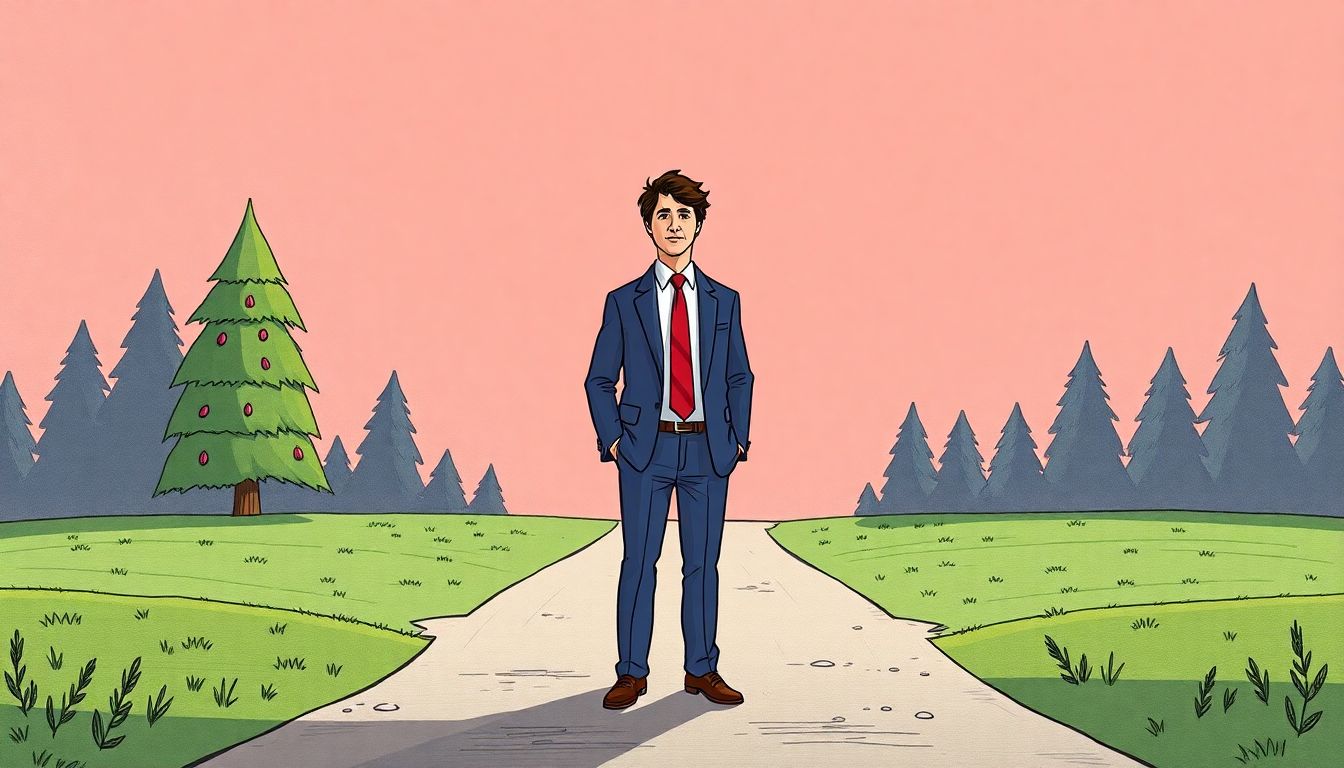
The Liberal Party’s Existential Crisis
In 2011, the Liberal Party of Canada faced an electoral reckoning. The once-dominant political force was reduced to a mere 34 seats, relegating them to third-party status—a historic low. This defeat wasn’t just an election loss; it was a symptom of deep, long-term trends that threatened the party’s very existence. The Liberals had long been seen as Canada’s ‘natural governing party,’ but this image had begun to fray.
Several interconnected factors contributed to this decline.
- Demographic shifts
- Regional alienation
- A lack of clear ideological identity
- Organizational atrophy
. The Liberals had become a party of the centre, but what that meant in practical terms had grown increasingly unclear. They were caught between a resurgent Conservative Party on the right and a reinvigorated New Democratic Party (NDP) on the left, both of which seemed to have a clearer sense of purpose and direction.
Just as the party seemed destined for a wilderness period and a much-needed rethink of its identity and policies, a familiar name stepped into the limelight: Justin Trudeau. The son of former Prime Minister Pierre Trudeau, Justin brought with him a sense of nostalgia, celebrity, and charisma that the party desperately needed. His rise to leadership in 2013 was swift and decisive, but it also prevented a deeper reckoning within the party.
Trudeau’s leadership brought an immediate electoral boost, culminating in a majority government in 2015. However, the party’s policies and identity remained largely unchanged. The Liberal Party continued to occupy the murky centre, with Trudeau’s personal brand often standing in for a clear, coherent political vision. While his leadership staved off immediate decline, it also meant that the deeper issues which had led to the 2011 defeat remained largely unaddressed. The party’s long-term health and political direction remain open questions, lurking beneath the surface of Trudeau’s charismatic leadership.
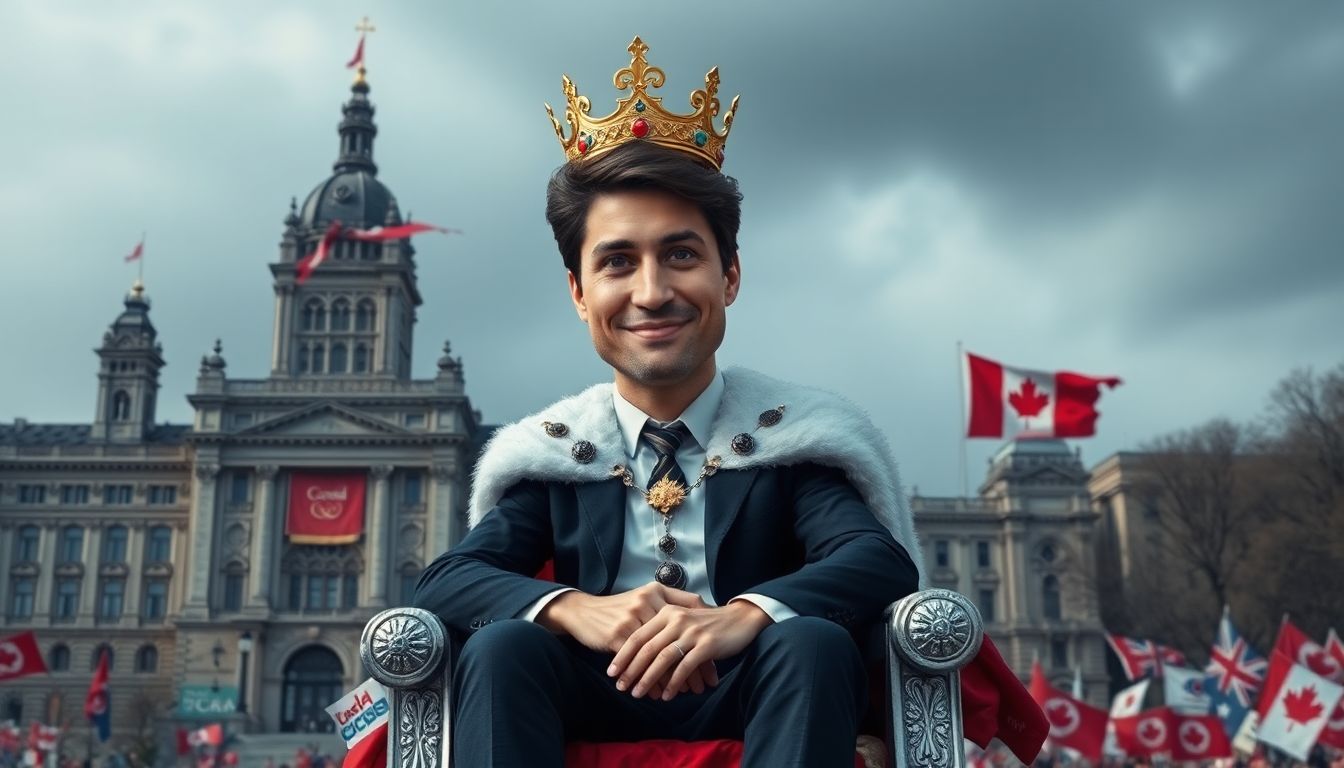
The Perils of Presidentialization
In recent years, the Canadian political system has witnessed a significant shift, with an increasing focus on party leaders that eerily mimics a monarchical structure. Elections have become more about the cult of personality surrounding leaders rather than parties’ policies or local candidates. This phenomenon, often referred to as the presidentialization of politics, sees party leaders acting more like presidents, with centralized power and increased visibility.
The implications of this trend on the durability of political parties are profound. As elections become more about leaders, the fortunes of political parties rise and fall with their leader’s popularity. This can lead to a volatile political landscape, where parties experience dramatic shifts in support based on who’s at the helm. Consider the Liberal Party’s resurgence under Justin Trudeau, or the Alberta NDP’s sudden rise with Rachel Notley. It’s not just about the party’s ideologies anymore, it’s about the leader’s charisma, marketability, and media prowess.
Moreover, the quality of local candidates has taken a backseat in this leader-centric political culture. With the spotlight firmly on the party leader, the caliber of local candidates seems to matter less. This is troubling for several reasons:
- It diminishes the role of MPs, who are supposed to be the voice of their constituents in Parliament.
- It can lead to a lack of diversity in political representation, as parties may opt for ‘safe’ candidates who won’t overshadow the leader.
- It can result in a dearth of political talent at the local level, as potential candidates may be discouraged by the lack of attention and influence.
This leader-focused trend also impacts the nature of political discourse. With parties rallying around their leaders, politics becomes more about personal attacks and less about policy debates. This can lead to a polarized political environment, where parties are more interested in scoring points against their opponents’ leaders than in engaging in constructive dialogue. Ultimately, this could lead to a dumbing down of political discourse, with soundbites replacing substance, and personality politics overshadowing policy discussions.
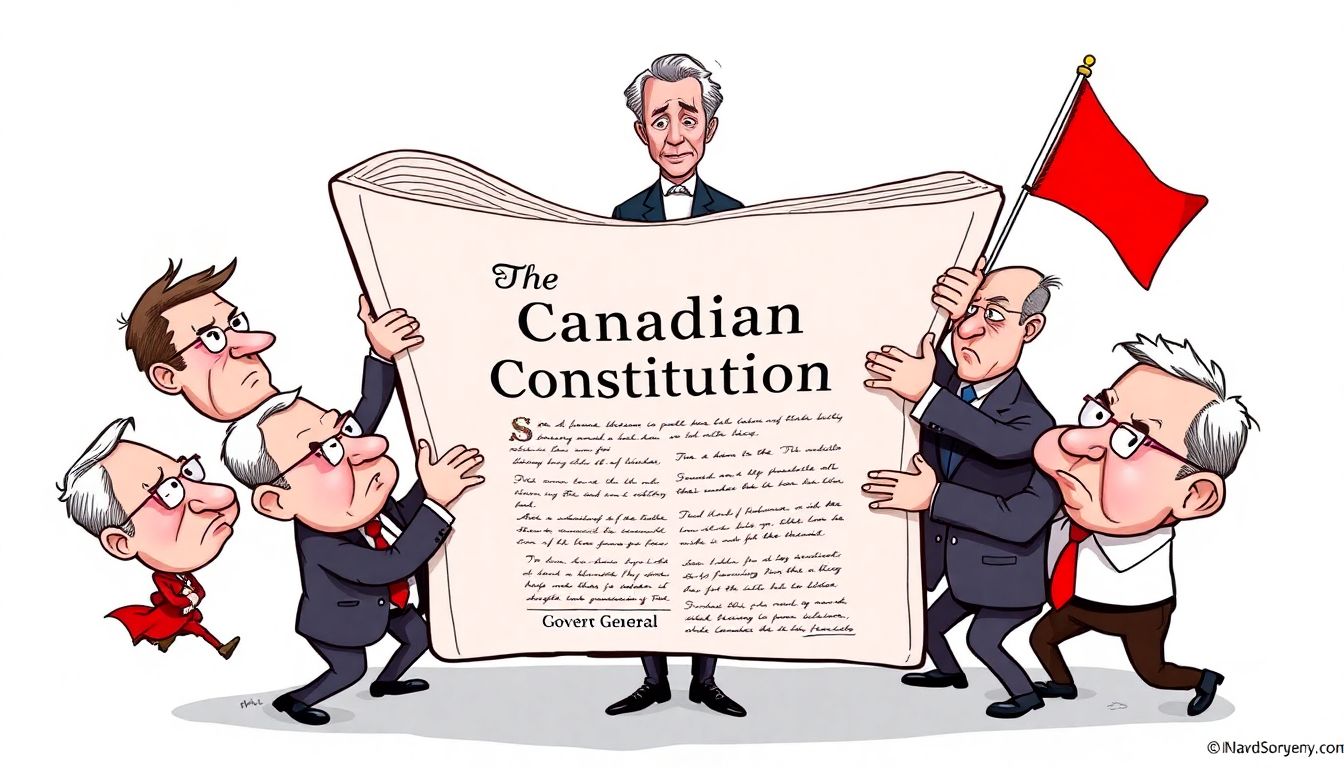
The Constitutional Crisis Looming
As we stand on the precipice of political turmoil, the specter of a constitutional crisis looms large. The first potential flashpoint is the issue of confidence votes. In a parliamentary system, a government rules only with the confidence of the house. But what if a ruling party, staring down the barrel of defeat, decides to defy this constitutional convention? We could see a situation where a government refuse to resign despite losing a confidence vote, sparking a showdown between the executive and the legislature. This could lead to a stalemate, where neither side backs down, leaving the country in a state of political paralysis.
Another potential crisis could arise from the proroguing of parliament. Prorogation is the formal name for the period between the end of a session of parliament and the state opening of parliament that begins the next session. However, it can be used as a political tool to temporarily shut down parliament and avoid scrutiny. Imagine a scenario where a government, facing intense pressure over a policy or scandal, decides to prorogue parliament to avoid scrutiny. This would not only set a dangerous precedent but also potentially plunge the country into a constitutional crisis, as the government subverts the democratic process to avoid accountability.
Moreover, as the political chaos unfolds, we could see an unprecedented level of judicial intervention. The courts, traditionally reluctant to intervene in political matters, might be drawn into the fray. Consider the following situations where the judiciary might have to step in:
- If a government refuses to resign after losing a confidence vote, the courts might have to rule on the constitutionality of this defiance.
- If parliament is prorogued to avoid scrutiny, the courts might have to decide if this action is a misuse of power.
In such scenarios, the judiciary could find itself in the crosshairs of political controversy, potentially sparking a crisis between the executive, the legislature, and the judiciary.
These potential constitutional crises paint a grim picture of the political chaos that could ensue. However, it’s crucial to remember that these are just possibilities, not inevitabilities. The future will depend on the actions of political leaders, the robustness of our institutions, and the vigilance of citizens. As we navigate these tumultuous times, it’s more important than ever to stay informed, engaged, and committed to the principles of democracy and the rule of law.
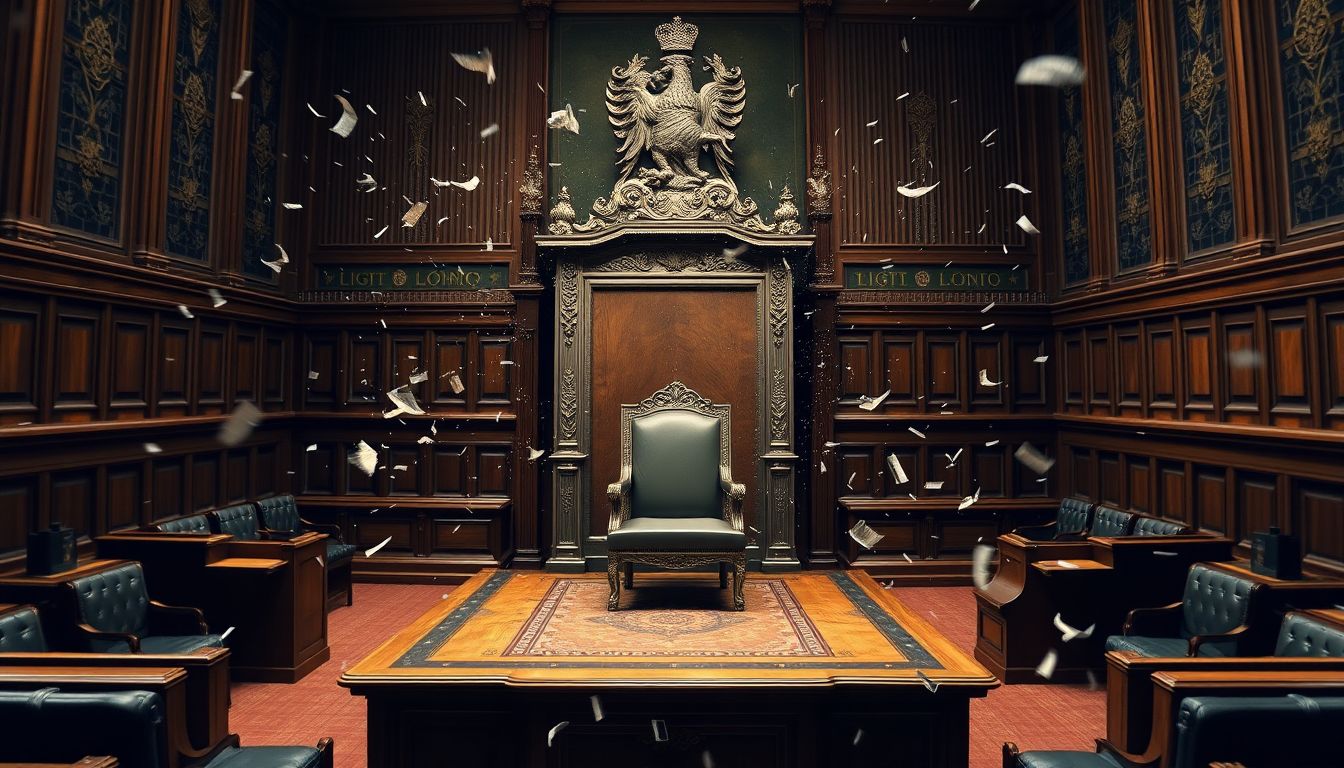
The Urgent Need for Leadership
In the throes of unprecedented challenges, our nation finds itself adrift, rudderless in the stormy seas of political uncertainty. The leadership vacuum at the highest echelon of government is no longer a whisper in the corridors of power, but a glaring reality that demands immediate attention. The urgent need for a prime minister who can steer the country through the coming storm is evident in every sector—from the economy to social welfare, from healthcare to foreign policy.
The role of a prime minister in these trying times is not just about occupying the highest office; it’s about providing vision, instilling confidence, and fostering unity. We need a leader who can navigate the complexities of Brexit’s aftermath, the economic downturn, and the lingering shadows of the pandemic. Someone who understands the intricacies of international diplomacy and can restore our standing on the global stage. A prime minister who can address the pressing issues of climate change, technological advancements, and societal divisions.
However, obtaining such a leader in the current political climate is a Herculean task. Here’s why:
- Polarization: The political spectrum is more divided than ever. Parties are fractured internally, and consensus is a rare commodity.
- Populism vs. Pragmatism: The pendulum swings between populist rhetoric and pragmatic policy, making it difficult for a balanced leader to emerge.
- Short-termism: The focus on immediate gains and election cycles hinders long-term planning and visionary leadership.
To fill this leadership vacuum, we must look beyond partisan lines and personal ambitions. It’s time for a collective reckoning, a shared understanding that the country’s interests transcend political affiliations. We need a prime minister who can unite, inspire, and lead—a beacon of strength and wisdom in the tempestuous days ahead. The future of our nation depends on it.
FAQ
What are the deep historic trends that threatened the Liberal Party’s existence?
- The shift of population and money to the West
- The vanishing Liberal brand at the provincial level
- The growing polarization of Canadian politics
.
What is the ‘winner-take-all’ nature of the Canadian political system?
What are the potential constitutional crises that could arise?
- Defying confidence votes
- Proroguing parliament to avoid no-confidence votes
- Judicial interventions in political decisions
.
What is the current leadership vacuum in Canadian politics?
What are the implications of the presidentialization of Canadian politics?
- A focus on party leaders at the expense of party policies and candidates
- A lack of durable support for political parties
- A dearth of quality candidates for party leadership
.



